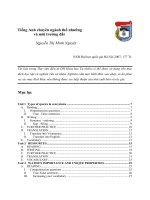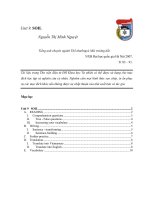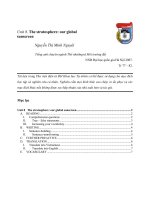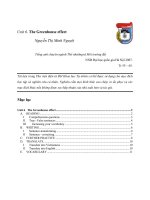Tiếng anh chuyên ngành Thổ nhưỡng và Môi trường đất
Bạn đang xem bản rút gọn của tài liệu. Xem và tải ngay bản đầy đủ của tài liệu tại đây (191.45 KB, 10 trang )
Tiếng anh chuyên ngành Thổ nhưỡngvà Môi trường đất
NXB Đại học quốc gia Hà Nội 2007.
Tr 101 – 109.
Tài liệu trong Thư viện điện tử ĐH Khoa học Tự nhiên có thể được sử dụng cho
mục đích học tập và nghiên cứu cá nhân. Nghiêm cấm mọi hình thức sao chép, in
ấn phục vụ các mục đích khác nếu không được sự chấp thuận của nhà xuất bản và
tác giả.
Mục lục
Unit 11 The origin And composition of soil..................................................................... 2
A. Reading......................................................................................................................2
I. Comprehension questions...................................................................................... 3
II. True - False sentences........................................................................................ 4
III. Increasing your vocabulary ............................................................................... 5
B. Writing....................................................................................................................... 5
I. Sentence-rephrasing .............................................................................................. 5
C. Further practice.......................................................................................................... 7
D. Translation................................................................................................................. 8
I. Translate into Vietnamese ..................................................................................... 8
II. Translate into English........................................................................................ 9
E. VOCABULARY ....................................................................................................... 9
Unit 11. The origin And composition of
soil
Nguyễn Thị Minh Nguyệt
Unit 11
The origin And composition of soil
A. Reading
a. Warm-up Activities
- What does weathering mean?
- Is chemical weathering different from physical one?
...........................................................................................................................................
Soil is the residue composed of two main ingredients: mineral material and organic
material.
2
Organic material originates from dead plants and animals and materials other
than this are derived from rocks of various kinds. These rocks are broken down into small
particles by mechanical disintegration and chemical decomposition. This breaking process,
known as weathering, may thus be both physical and chemical.
5
When weathering processes are largely physical-by heat or wind, for instance-the
composition of the soil is very similar to that of parent rock. In arid regions weathering is
mostly by physical means. But in humid regions chemical processes of weathering are
equally important.
8
In such regions rock particles are affected by water which may contain
carbonic or other weak acids. These acids dissolve some of the particles in the rocks. The
mineral material that is left behind is insoluble. Consequently, the insoluble mineral residues
in the soil have less resemblance to the original rocks. There are large amounts of organic
matter in the so down il, too.
The process of soil formation results in the development of the soil profile.
14
This is
made up of a succession of horizontal layers, or "horizons", of varying thickness, from the
surface to the parent rock. Generally speaking, there are three distinct horizons, known as
A, B and C. A is the topsoil, which is coarse-grained, and dark in color because of the
presence of humus. B is known as the sub-soil which contains some of the products
leached, or washed, out of the A-horizon. The C-horizon consists of parent material which
has been weathered in the upper part, and unweathered rock bellow.
Any sample of soil contains particles of different sizes.
20
These have been divided into
the following size groups:
Material Diameter (mm)
Gravel
coarse sand
fine sand
silt
clay
more than 2.0
2.0-0.2
0.2-0.02
0.02-0.002
less than 0.002
Soils range from pure clays to pure sands.
22
Most of them contain various proportions
of sand, silt, and clay and these varying proportion make up a soil 's textural class. The
principle classes in order of increasing fineness of material are sand, loamy sand, loam,
silt, silty clay loam, clay loam, silt and clay.
Any soil contains both mineral and organic matter.
25
Clay particles are the most
important of the mineral particles because they are the smallest. Smaller the sized particles
have a greater exposed surface area than larger sized particles. The smaller the size of a
particle, the greater is its reactivity. That is to say, smaller sized particles can react or
combine with water, nutrients and humus more easily than larger sized particles. Thus, a
clay soil is more reactive than any other type of soil. Humus from decomposed organic
matter is vital to a soil as it makes a heavier soil lighter.
31
In addition, it helps to bind the
mineral particles together in "crumbs".
(Taken from "English in Agriculture" by Alan Mountford)
I. Comprehension questions
Answer the following questions
1. What are the two major ingredients of soil?
...........................................................................................................................................
...........................................................................................................................................
2. Where does organic material and inorganic material originate?
...........................................................................................................................................
...........................................................................................................................................
3. When is the composition of the soil and the parent rock the same?
...........................................................................................................................................
...........................................................................................................................................
4. What are the rock particles in humid regions affected by? What does water in such
regions consist of?
...........................................................................................................................................
...........................................................................................................................................
5. What kind of material is insoluble when acids dissolve some particles in the rocks?
...........................................................................................................................................
...........................................................................................................................................
6. What lead to the development of the soil profile?
...........................................................................................................................................
...........................................................................................................................................
7. How many distinct horizons are there? What are they? What are the C-horizon
composed of?
...........................................................................................................................................
...........................................................................................................................................
8. What is the color of the topsoil? How many groups can we divide particles of different
sizes into?
...........................................................................................................................................
...........................................................................................................................................
9. Why are clay particles the most important of the mineral particles?
...........................................................................................................................................
...........................................................................................................................................
10. What is the importance of humus?
...........................................................................................................................................
...........................................................................................................................................
II. True - False sentences
Decide whether the following statements are true "T" or false "F". Correct the false
sentences.
1. ...... Mineral materials in soil are derived from various kinds of rocks.
2. ...... Physical weathering doesn't break down rocks into particles, neither does
chemical one.
3. ...... The composition of the soil in arid regions has a close resemblance to that of
the parent rock.
4. ...... Soils in arid regions and soils in humid regions are the same.
5. ...... Soils in humid regions are similar to the parent rock.
6. ...... There are a succession of soil horizons from the surface to the parent rock.
7. ...... Particles bigger than silt are clay particles .
8. ...... A clay loam contains particles of greater fineness than a loamy sand.
9. ...... Gravel particles are the least important of the mineral particles because of
being the biggest.
10. ...... If the size of a particle is larger, its reactivity is better.
III. Increasing your vocabulary
Synonyms: Find words or phrase in the text which have the same meaning as:
1. areas ....................................
2. damp ....................................
3. incapable of being dissolved ....................................
4. cohere ....................................
5. original rocks ....................................
6. rot ....................................
7. rough ....................................
8. similarity ....................................
9. small stones ....................................
10. substance that provides essential nourishment ....................................
B. Writing
I. Sentence-rephrasing
Rewrite the following sentences replacing the words printed in italics with
expressions from the text which have the same meaning :
1. Material other than mineral material is derived from dead plants and animals.
...........................................................................................................................................
...........................................................................................................................................
2. Breaking down rocks into small particles
is performed mostly by heat or wind in arid
and semi-arid regions.
...........................................................................................................................................
...........................................................................................................................................
3. The remains of mineral materials that can not be dissolved in water have litter
similarity to the parent rocks in humid regions.
...........................................................................................................................................
...........................................................................................................................................









